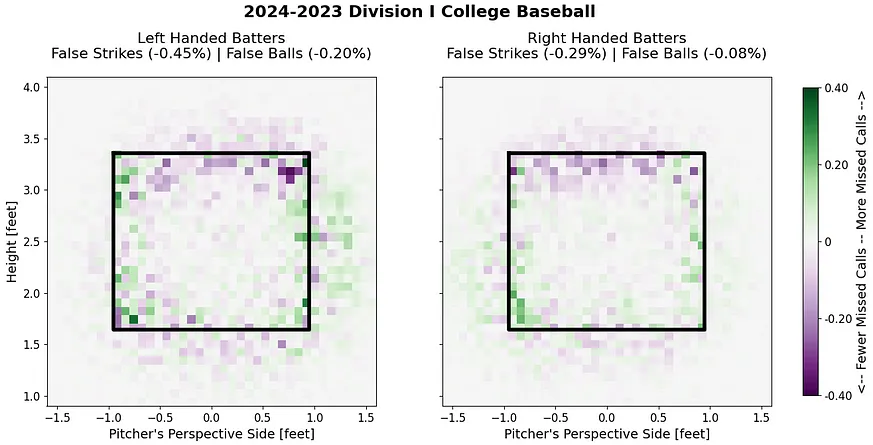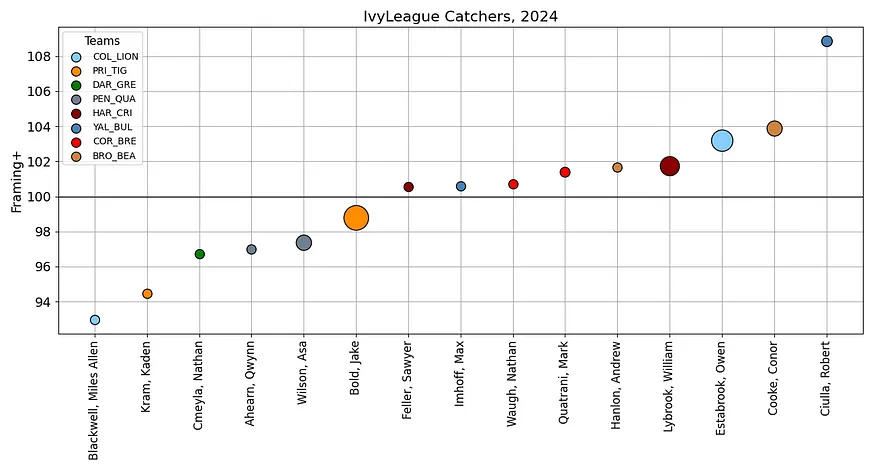Summary
Understanding the college baseball strike zone is crucial for players, coaches, and fans alike as it shapes the dynamics of every game. This article delves into the nuances of strike zone rules and their implications on performance. Key Points:
- Analyzing umpire consistency reveals how biases in strike zone calls vary across games, leagues, and individual batters, impacting game outcomes.
- The evolution of catchers' framing techniques demonstrates how subtle movements can influence pitch perception and ultimately affect strike calls.
- A data-driven approach to strike zone analysis uses advanced statistics to quantify the impact of umpire decisions on batting averages and win probabilities.
Let’s take a closer look at the 2024 Division I college baseball season. Across the nation, Stadium Trackman systems captured data on 1,360,519 pitches. Out of these, there were 749,030 instances where umpires called balls or strikes without a swing being taken. Notably, among these calls, 87,334—equating to 11.5%—were deemed incorrect. In this context, an incorrect call refers to situations where an umpire ruled a pitch as a ball when it actually fell within the strike zone defined by Major League Baseball (referred to as 'false balls'), or conversely, declared a strike for pitches that were outside this designated zone ('false strikes').
Key Points Summary
- The lowest success rates for catcher framing are in the upper left, directly above, and upper right areas of the strike zone.
- These areas are located at the top edge of the strike zone, which may contribute to their low success rates.
- Catcher framing involves receiving pitches in a way that influences umpires to call strikes more often.
- Effective framing techniques include presenting a clear view of the pitch to umpires by catching it out in front of the body.
- The strike zone can be divided into a 3 × 3 grid, with additional regions outside this zone affecting how pitches are perceived.
- Catcher framing is an important aspect of baseball strategy that combines technique and psychology.
In baseball, catcher framing is crucial for getting those borderline pitches called as strikes. Interestingly, research shows that some areas at the top edge of the strike zone see much lower success rates for this technique. This highlights just how subtle and strategic every pitch can be—it`s not just about throwing or hitting; it`s also about how well catchers can influence umpire decisions. It’s a fascinating dance between players and officials that adds another layer to this beloved sport.
Extended Comparison:| Area of Strike Zone | Success Rate for Catcher Framing | Framing Technique | Psychological Factors | Latest Trends |
|---|---|---|---|---|
| Upper Left | Low | Catching pitch out in front of body | Umpire perception influenced by framing technique | Training programs focusing on upper zone framing |
| Upper Right | Low | Use of glove to create a visual illusion of strike zone edge | Confidence building through practice and simulation games | Emergence of technology to analyze framing effectiveness |
| Middle Left | Moderate | Quick hand movement to present pitch as a strike | Understanding umpire tendencies and biases over time | Increased focus on biomechanics for better positioning |
| Middle Right | Moderate | Utilizing wrist flexibility for optimal glove presentation | Building rapport with umpires through consistent performance | Data analytics providing feedback on individual performance |
| Lower Zones (Left & Right) | High | Staying low while catching pitches, presenting clear angles | Emphasizing the importance of communication cues with pitchers | Integration of video analysis tools for real-time improvement |
Translate Your Content to English for Wider Reach
Please translate to English and place it in {}.
As more stadiums begin to implement Trackman technology, leagues have started assessing umpires based on the accuracy of their strike calls—at least that's what the umpires claim. Players and coaches have noted a perceived tightening of the strike zone in light of these evaluations, a feeling that appears to be supported by Figure 2, which indicates a 5.2% reduction in missed calls from 2023 to 2024.

Table 1 provides an overview of the differences between Division 1 baseball in 2023 and 2024. On a positive note, we are witnessing a rise in the number of games played at stadiums equipped with Trackman technology. However, there's a downside: as more programs adopt Trackman systems and additional leagues along with umpires share their data, we are observing an unexpected increase in both the average size and variability of the strike zone (as shown in Table 1), contrary to our initial expectations depicted in Figure 2.

The information in Table 1 raises an interesting question about how umpires from the Ivy League stack up against their counterparts in the Southeastern Conference (SEC) and Major League Baseball (MLB). According to Table 2, it appears that only around half of the games played in the Ivy League, including playoffs, are monitored by Trackman technology. When we look at trends from 2023-2024 within the Ivy League, we notice that the SEC experienced a more significant drop in calls for false balls, alongside a slight uptick in calls for false strikes (as evidenced by Table 2). On a broader scale, the SEC's strike zone is not only 10% smaller than that of the Ivy League but also exhibits considerably less variation. In contrast, MLB's strike zone is even more compact—21% smaller than that of the SEC—and shows marked consistency as well (refer to Table 2).



Having established our understanding of the dimensions, shape, and count-dependence of the Division 1 strike zone, as well as examined the consequences of overlooking dynamic vertical zone coordinates, let’s explore some practical examples of how we can utilize the geography of the strike zone to gain a competitive edge.
Quantifying the Impact of Umpire Decisions on Game Outcomes
**1. Quantifying Umpire Impact on Game Outcomes:** While we understand umpire tendencies, the next step is to quantify their impact on game outcomes. This can be done by simulating games with different umpire strike zones and analyzing the resulting win probabilities, runs scored, and other relevant metrics. By understanding how umpire variation influences game dynamics, teams can better strategize and adjust their approaches, especially during crucial moments.}**2. Evaluating the Efficiency of Adjusting to Umpire Tendencies:** The ability of players and coaches to adapt to specific umpire tendencies warrants thorough evaluation. For instance, examining whether a pitcher's adjustments in pitch location lead to statistically significant improvements in strike percentage when facing a particular umpire could provide valuable insights into competitive strategy. By contrasting player performance data with and without prior knowledge of these tendencies, we can assess the true value of advanced scouting methods in gaining a competitive edge.
{**2. Evaluating the Efficiency of Adjusting to Umpire Tendencies:** The effectiveness of players and coaches adapting to specific umpire tendencies needs to be assessed. For example, does a pitcher's adjusted pitch location lead to a statistically significant improvement in strike percentage with a particular umpire? By comparing player performance with and without knowledge of umpire tendencies, we can determine the value of this advanced scouting and its potential impact on competitive advantage.



Analyzing SEC Catchers′ Framing Skills: Statistical Significance, Sample Size, and Contextual Performance
In assessing SEC catchers' framing capabilities and interpreting data accurately, it's critical to account for statistical significance and sample size while contextualizing individual performances against broader averages in Division I baseball.At Princeton, our goal is to analyze Framing+ statistics more thoroughly to identify which pitchers and pitch types our catchers excel with, as well as the areas of the strike zone where they face challenges. Catching coach KJ Hallgren utilizes a pitching machine programmed to replicate the most difficult pitches for each catcher (we'll be sharing a post on this topic soon). He then combines slow-motion video analysis with Trackman data to develop tailored drills aimed at enhancing their receiving skills. In contrast to MLB, the strike zone in Ivy League baseball presents its own unique challenges. We're just beginning to gather sufficient data that reveals competitive edges hidden within this complex landscape.
References
【新功能更新】捕手偷好球(Catcher Framing)
以聯盟整體而言,偷好球成功率最低的三個區域–左上、正上、右上,剛好都位於好球帶的上緣,出現此現象可能有兩 ...
Source: Rebas 野球革命Statcast Catcher Framing Leaderboard | baseballsavant.com
Catcher framing is the art of a catcher receiving a pitch in a way that makes it more likely for an umpire to call it a strike. This page breaks down the ...
Source: Baseball Savant六分鐘-智慧看棒球棒球觀賽懶人包– 標籤"Catcher Framing"
棒球比賽中包含許多運動科學相關知識,如投手投球球路,打者打擊心理戰,捕手配球,甚至有關比賽數據的細節知識。STRIKE 智慧棒球不只提供器材,也陪你一起了解職業棒球球賽 ...
Source: STRIKE Smart BaseballCatcher Framing | Glossary
Catcher framing is the art of a catcher receiving a pitch in a way that makes it more likely for an umpire to call it a strike -- whether that's turning a ...
Source: MLB.com【大聯盟小百科】捕手偷好球(Catcher Framing)
捕手這種創造不同視覺效果、進一步「欺瞞」或「誤導」主審、使主審把邊邊角角的球判成好球的能力,被稱作「偷好球」(Catcher Framing)。
Source: Blogger.comBaseball Instruction: Catching: How to Frame the Pitch
When you frame the pitch, try to give the umpire a clear view of where you caught the ball. To do this, catch the ball out in front of your body with a slightly ...
Source: QCBaseball7 Catcher Framing – Analyzing Baseball Data with R (3e)
The strike zone itself is divided into a 3 × 3 grid, with four additional regions defined outside of the strike zone. We first compute the observed probability ...
Source: GitHub PagesIs Catcher Framing Cheating? - by Lewie Pollis - The Lewsletter
Jeter exploited an information-asymmetry that theoretically should not exist in order to turn a foul ball into a free base. I call that cheating.
Source: The Lewsletter


 ALL
ALL sports
sports
Discussions